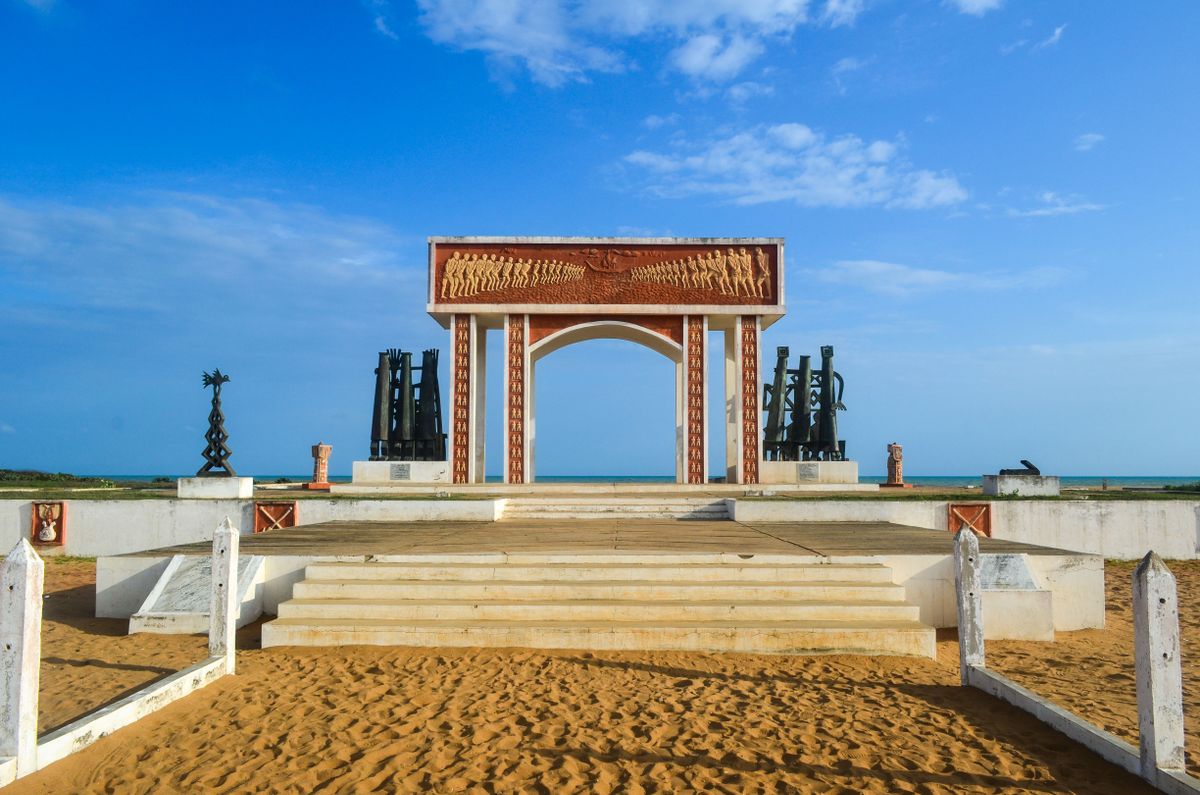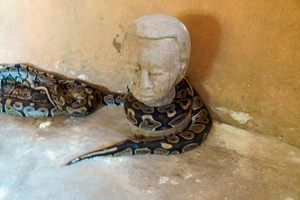About
Over the course of two centuries, more than one million enslaved Africans were deported from the town of Ouidah on the coast of Benin. They were marched in chains from the town’s slave market to the nearby port, where they would board ships to unknown destinations, the majority of them never to return. They were often blindfolded, and marched in circles around the few trees or few obstacles along the way, to make them forget where they came from, surely physically so they wouldn't try to escape, as well as symbolically. Today, a memorial arch, known as La Porte du Non-Retour (The Door of No Return), stands on the beach, a monument to the horrors of slavery.
The massive slave trade in Benin was a cooperative effort between African rulers and private merchants. From the 1580s to the 1720s, the coastal Kingdom of Whydah exported around 1,000 slaves a month, many of them taken captive during tribal wars in the interior. These enslaved men were then taken to Ouidah, where they were sold to European and Arab merchants. This practice continued with the Kingdom of Dahomey, which conquered Ouidah in 1727, up until the end of the slave trade in the 1860s.
From the slave market in Ouidah, the enslaved Africans had to walk a few miles to the coastline, where ships waited to take them away, to Jamaica or Brazil or some other unknown destination. Small rowboats would take them out to the larger ships, and some would jump overboard in the rough water rather than face the uncertainty of the voyage or the life ahead. For most, the beach at Ouidah was the last sight of Africa they would ever see.
In the early 1990s, the Beninese government, with help from UNESCO, began a project to commemorate the victims of the slave trade. The Slave Route Project, as it was known, led to the creation of a series of statues, monuments, and installations beginning in the town and continuing along the dirt road to the beach—the final journey for so many enslaved Africans before they were deported.
The largest and most impactful memorial stands at the end of the Slave Route. This is the Door of No Return, a memorial arch, or gateway, built in 1995. Both sides of the arch are covered in images of enslaved men and women. The main mural on the inland-facing side depicts enchained men walking toward the sea, a ship waiting for them in the distance. On the sea-facing side, the mural shows them walking away from their homeland, a single tree in the distance representing the land that most of them would never see again.
Bronze sculptures stand at either side of the arch. Some represent the enslaved Africans: oxidized bronze figures in chains, staring out at the sea. And nearby stands a cement Egungun, a traditional masked figure that recalls departed ancestors. It’s a powerful collection if images, and—at least in some way—expresses the final thoughts of the enslaved men and women as their feet sunk into the sands of coastal Ouidah, and of Africa, for the very last time.
Related Tags
Know Before You Go
The Door of No Return is located on the beach about three miles south of Ouidah. The Slave Route runs from the town to the Door of No Return, with various statues and monuments—some now faded or damaged—along the route. Ouidah is a city on the coast of the Republic of Benin, about 45 miles west of the capital Porto-Novo.
Rhythms & Rituals: West Africa's Spiritual Traditions
Floating villages, bustling markets, clay castles, and mesmerizing ceremonies in West Africa.
Book NowCommunity Contributors
Added By
Published
December 30, 2019
Sources
- local historians
- http://slaveryandremembrance.org/articles/article/?id=A0120
- https://medium.com/from-traditional-to-contemporary-aesthetic/the-slaving-port-of-ouidah-and-monumental-discourse-around-the-atlantic-perimeter-a41968341a57
- https://unseenbenin.wordpress.com/2014/03/02/la-porte-du-non-retour-the-door-of-no-return/
- https://books.google.com.pe/books?id=w-k-J8M_pTgC&pg=PA345&lpg=PA345&dq=Door+of+No+Return+(Benin):&source=bl&ots=McPqvS7H-W&sig=ACfU3U0rOA2y-BCPiMvS2CRUdG87thyeWg&hl=en&sa=X&ved=2ahUKEwix2ZfL9MTmAhXfIrkGHVbtABwQ6AEwFnoECBcQAg#v=onepage&q=Door%20of%20No%20Return&f=false
- https://books.google.com.pe/books?id=bFEqDwAAQBAJ&lpg=PA81&dq=Door%20of%20No%20Return%20(Benin)%3A&pg=PA67#v=onepage&q=Door%20of%20No%20Return%20&f=false


































